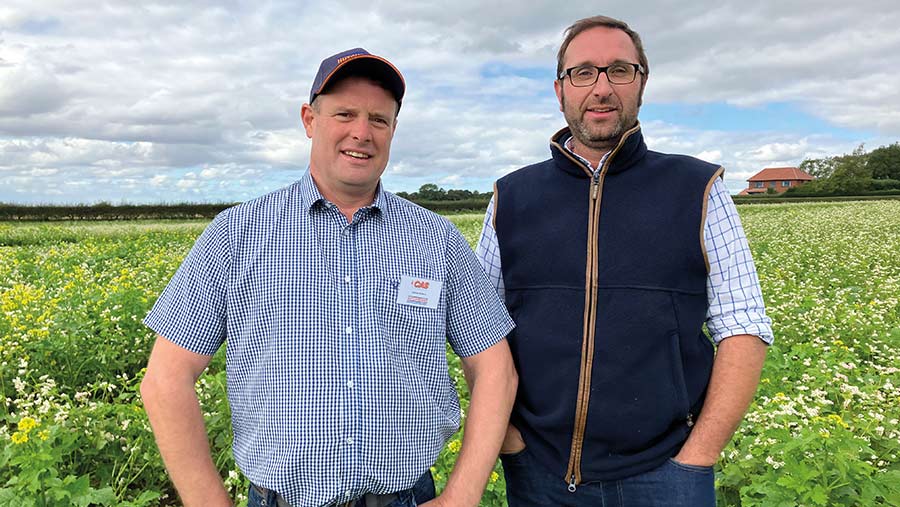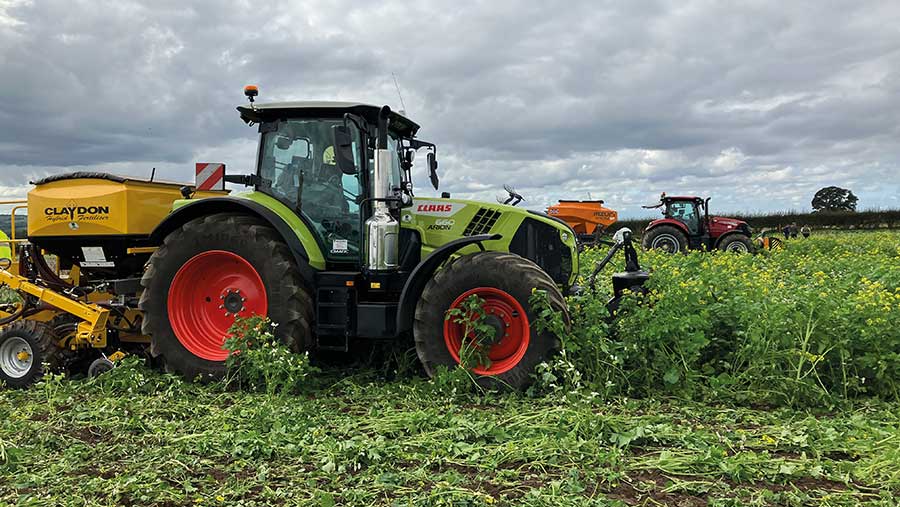Costs up and yields down for Cheshire potato farmer
 Andrew Roberts and Andrew Shaw © MAG/Emma Gillbard
Andrew Roberts and Andrew Shaw © MAG/Emma Gillbard The cost of growing potatoes is struggling to stack up for Cheshire farmer Andrew Shaw and he is calling for the wider industry to negotiate a better price for farmers.
With the price of fuel and fertiliser at record highs, Mr Shaw’s production costs stand as high as £150/t, while some of his contract price fails to cover this, at £140/t.
See also: Why growers need to use sprout suppressant early this season
Yields down this harvest
Not only are costs up, but current yields are down by 12.5t/ha at Aston Grange Farm, as a result of the spring drought conditions that stressed crops and consequently limited yield.
This year’s harvest began in June with a crop of early potatoes planted in March. Varieties grown consist of Accord, Miranda, Arcade and old favourite Maris Piper.
Early crop yields would usually achieve 25t/ha and later crops double this at 50t/ha, but performance is failing to hit where Mr Shaw would hope.
“Growers are struggling against the rising costs and lower yields due to the drought. In fact, one of our fields died off in mid-July in the heat,” he says.
Unlike global commodity markets such as wheat, barley and grain, the UK potato market has failed to keep up with input price hikes, placing financial pressures on to the farming sector.
Need for market uplift
As growers face an additional £40-50/t cost hike on seed potatoes next year, Mr Shaw highlights the need for an uplift in the market to enable growers to continue production – ideally with a £70-80/t price increase across contracts to reflect escalating input costs.
“The industry has got to understand that we cannot carry on the way we are. Next year will be a huge breaking point. How can farmers continue growing potato crops, when we don’t even know the price we will be paid? How can we plan or budget? It just doesn’t add up.”
Mitigating costs
In the meantime, Mr Shaw plans to focus on improving soil health and cutting back on inputs, to secure a more financially viable future in the potato sector.
He hopes that a combination of cover cropping and precision farming techniques will improve resilience to a range of weather extremes and be less reliant on chemical inputs across his sandy loam and sandy silt loam soils.
The ultimate aim is to establish a min-till potato production system that significantly cuts back the number of intensive machinery passes and costly fuel expenditure.
Terra mapping
One way Mr Shaw hopes to achieve this is through the use of the high-resolution soil mapping service – TerraMap – on offer from Omnia Precision Farming.
The technology uses gamma-ray detection to accurately asses a range of soil properties that include texture, nutrient analysis, pH, organic matter, carbon levels and plant available water.
The farm has been TerraMapped over the past three years, with a view to varying potash, magnesium and seed rates in potatoes.
The benefit of this technology is that it is not affected by soil moisture, compaction, crop cover or cultivation state, so there are few limitations to when TerraMap can be used.
This offers a much wider operating window for soil scans compared with other systems, with more than 800 data reference points/ha and 27 high-definition soil property layers.
“It’s great to know exactly what are soils are doing and understand the science behind why specific fields are behaving in certain ways. What has been particularly stand out is pH mapping and we’re working on improving this.”
Furthermore, the team plan to use NDVI biomass maps to vary nitrogen content and scale back on liquid fertiliser across milling wheat varieties, as well as variably applying seed rates and lime.
Cover cropping

Drilled cover © MAG/Emma Gillbard
After dabbling with the use of cover crops at Ashton Grange Farm, Andrew Shaw planted a diverse species mix of buckwheat, oil radish, mustard and clover to improve biodiversity and soil structure.
“Previously, autumn weather has been challenging, which made it difficult for us to establish covers, but we’re now taking the opportunity after an early harvest and dry drilling period to get them established,” says Mr Shaw.
Working closely with his Hutchinsons’ agronomist Andrew Roberts, 40ha of covers were planted following potatoes and cereals.
“We hope to encourage rooting and worm populations through cover cropping and also increase water uptake and therefore widen the drilling window.
“However, it’s important to prevent covers from going woody as the benefits and nutrients returned to the soil will not be so apparent,” explains Mr Roberts.
Cover trial and drill demo
Mr Roberts continues that the team are trialling three different cover crop species mixes after an early crop of potatoes that were direct drilled into winter wheat at a recent Hutchinsons open day at Ashton Grange Farm.
After an early July harvest, covers were planted in early August, grown for six weeks and drilled with six different drills to assess which system and crop best suits the farm and showcase this to a range of farmers.
The covers established were:
- Maxi cover: buckwheat, white mustard and berseem clover, designed for rapid growth
- Maxi veg: linseed, buckwheat phacelia and crimson clover
- Maxi impact: sunflowers, linseed, buckwheat, phacelia, crimson clover and berseem clover
The drills trialled were:
- Kverneland 6m Uni drill
- Weaving 6m GD
- Horsch Avatar 6m
- Sky Agriculture Easy drill 6m
- Claydon Hybrid disc 3m
- Mzuri Pro till 3m
A follow-up open day will take place next February to outline establishment results, with plans for another open day in June.

